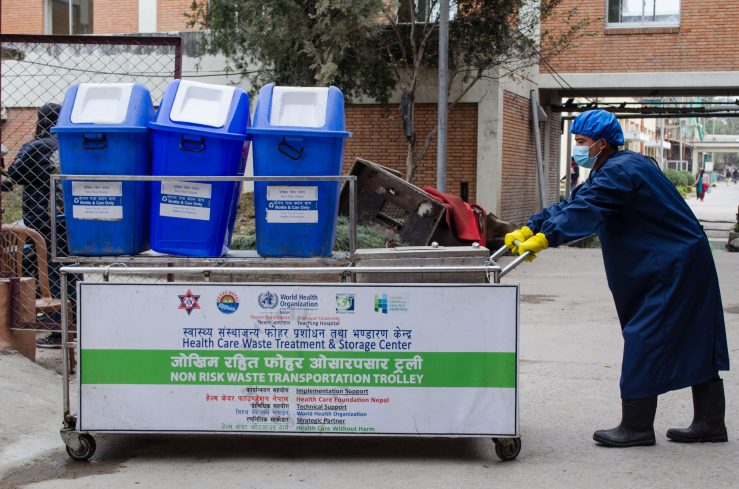Find out about the waste management practices implemented by Tribhuvan University Teaching Hospital, a member of the GGHH network in Nepal.
Located in Kathmandu, Tribhuvan University Teaching Hospital (TUTH) is the biggest hospital in the country. With a capacity of 700 beds, and serving hundreds of walk-in patients per day, the amount of waste produced is a public health problem. When working at full capacity, the hospital can generate up to one ton of waste per day.
“Most waste from hospitals is like ordinary domestic waste, but if it is mixed with infectious and other hazardous materials, it threatens human and environmental health. Hospitals that burn their waste destroy recyclable resources, emit local air pollution, and contribute to climate change,” says Ruth Stringer, Science and Policy Coordinator, Health Care Without Harm.

Segregation trolley at TUTH. Credit: HECAF360.
In 2014, HECAF conducted a diagnostic assessment at TUTH to identify any restraints as well as to quantify the waste volume. In February 2017 the project was implemented and Health Care Without Harm and HECAF360 started working with WHO Nepal on sustainable waste management practices at TUTH. The report on the initiative and its results, produced in collaboration with the Institute for Global Environmental Strategies (IGES), is now available for download.
Health Care Without Harm and HECAF360 developed six excel-based waste trackers, designed to help determine how waste is produced, managed and controlled in health care institutions. These trackers were one of the tools used in the work with TUTH.
The teams worked with hospital management and staff to find the most effective solutions. A series of strategies and initiatives were proposed for waste segregation, treatment, and transport such as:
- Installation of a vacuum autoclave to treat all infectious waste except pathological waste. HECAF360 and Health Care Without Harm had already established a method to collect syringes in large metal drums for disinfection, which would not be possible with other technologies,
- installation of a biodigester to treat organic waste, such as food waste and placentas. This increased the hygiene levels both in the hospital and outside,
- use of segregation trolleys equipped with color-coded bins to help staff separate waste by the bedside,
- use of needle cutters to reduce the risk from needles. These devices cut the needle off syringes, often along with the tip of the syringe, so that another needle cannot be attached to it. This helps prevent the reuse of syringes, a common problem in some countries,
- safe transport of waste to the treatment center, including separate trolleys for hazardous and non-hazardous waste, and routes designed to avoid public and sensitive areas, such as food preparation areas, as much as possible.

Composition of waste, TUTH. Source: Prepared for the case study.
Find out more about the work with TUTH, Nepal, here.
“This case study shares good practices and lessons learned on the sustainable health care waste management in Tribhuvan University Teaching Hospital in Nepal, which is largely based on the 3Rs concept: Reduce, reuse, and recycle. It also highlights the importance of adopting appropriate technologies to minimize exposure to health risks and therefore help improve public health, well-being and ecosystems,” explains Premakumara Jagath Dickella Gamaralalage, Principle Researcher/ Director of the IGES Centre Collaborating with UNEP on Environmental Technologies (CCET).
As a result of this joint program, levels of cleanliness have increased both indoors and outside mostly due to the proper sorting and processing of general and food waste. Around a third of the waste collected can be now processed and sold to recyclers, with another third disposed of in the biodigester. Greenhouse gas and air pollutants emissions were reduced due to the use of autoclaves instead of incineration for hazardous waste. In addition, during the 2014 survey, it was found that nearly 60% of the staff suffered needle injuries during work, and with the implementation of these initiatives the cases were almost reduced to zero.
Download the Health care waste trackers, an interactive toolkit developed by Health Care Without Harm and HECAF360. These tools are designed to help health care institutions determine how waste is produced, managed and controlled.

